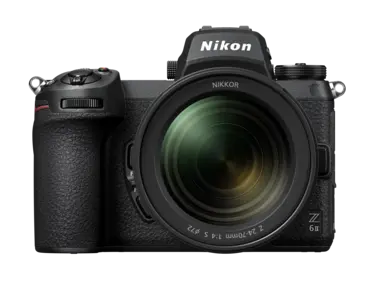Understanding camera focus modes

Can’t seem to nail focus? You may be using the wrong setting
Photos blurry and can’t figure out why? Your focus mode might be the issue. Here we’ll cover focus modes from the ground up, starting with what they are and which ones to choose.
What are camera focus modes?
Focus modes are how you tell your camera’s automatic focusing (AF) system to work. Your camera will prioritise a certain area of the image depending on which one you choose.
There are four main AF modes:
- AF-S: Autofocus single-area
- AF-C: Autofocus continuous
- AF-F: Full-time autofocus
- MF: Manual focus
Plus sub-modes:
- AF-Area: Sub-modes of the categories above that allow for more accuracy
Newer mirrorless cameras also come with options such as subject detection autofocus, which we’ll cover below as each Nikon camera has different capabilities.
AF-S mode
Best for subjects that aren’t moving, AF-S refocuses your camera before every individual shot you take. It’s a good focus mode for landscapes, studio portraits and product photography, as you can see in the video above.
To focus your camera in AF-S mode, press the shutter down halfway. Your focus point will turn from red to green, you’ll hear a beep, and you can press the shutter fully to take your photo. If the camera can’t focus, you won’t be able to engage the shutter and your focus point will blink red.
This mode does not track moving subjects. The camera will stay focused on one point as long as you have the shutter half-pressed. But if you move the camera, it will not refocus until you release the button and half-press the shutter again.
AF-C mode
AF-C continuously hunts for focus as long as the shutter button is half-pressed down, making it ideal for photographing action. Fast-paced subjects such as athletes and wildlife, as in the above video, lend themselves well to AF-C. If you have a moving subject, use this mode. If not, don’t, as the camera will work harder than it has to.
AF-Area modes you can use with AF-C, such as dynamic area AF and wide-area AF, are particularly good for unpredictably moving subjects such as football players and running animals.
AF-F mode
With this mode activated, half-press the shutter button to lock your focus point. Once it’s locked, the camera will maintain focus on that point. This is particularly useful for people who film themselves. They can simply lock the focus point on their eye and know the camera will keep them in focus as they move. You can only use AF-F in video mode.
MF mode
MF or manual focus mode gives the user full control. MF mode is becoming less commonly used because autofocus has progressed so far, but it certainly still has a place in photography.
If your camera can’t find the necessary contrast to focus, you can switch to MF and dial it in yourself. In dark environments, for example, night or concert photography, manual focus is often essential since there may not be enough light for the sensor to find contrast. Photographing moving subjects in manual mode is much harder but, with practice, it is possible. You can see the creative difference in the video above.
AF-Area modes
AF-Area modes are more specialised sub modes within the ones listed above. Some allow for more accurate subject tracking, while others refine a single focus point even further than normal.
Some examples include:
- Pinpoint AF: In photo mode, pinpoint AF lets you choose a smaller focal point to concentrate on a fine detail, and is selected from within AF-S mode. Used when you need super accurate focus, this mode is best for static subjects such as product photos or studio portraits.
- Dynamic area AF: The camera focuses on a point you select. If the subject leaves that point, the camera uses info from the surrounding area to refocus. It’s good for fast-action photography such as sports. When selecting this option in photo mode you can choose a small (S), medium (M), or large (L) area.
- Wide area AF: Similar to pinpoint AF, this mode chooses an area of several focus points to maintain focus on a subject. As with dynamic area AF, you can set a small (S) or large (L) area. This mode can be used in single-shot or continuous AF and is good for tracking moving subjects. You can use it in photo or video mode.
- Auto area AF: If a face is detected within the frame focus priority is automatically directed there, useful when you don’t have time to select the focus point, such as spur of the moment photos.
- 3D Tracking: Very useful when shooting fast moving subjects, 3D Tracking enables the AF point to follow the subject, allowing you to quickly recompose a shot without losing focus,
And there are many more. How many of them you can access depends on what camera body you have, so check your camera’s manual to know for sure. The Z6III, Zfc, and Z9 manuals give you an idea of what options you’ll get with each level of camera body.

A selection of AF-area modes on a Nikon Z6III
Subject detection autofocus
Subject detection AF locks on to the subject of your image and maintains focus while you photograph or film. Nikon cameras have subject-detection capabilities across six categories:
- Auto: Detects and focuses on anything the camera considers a subject, for example, people, animals or vehicles.
- People: If the camera sees a human face, it generates a focus point to track it. If it detects eyes, it will lock focus on an eye and track that as the person moves. If they turn away from the camera, the camera tracks them with a focus point on their head.
- Animals: The same as People mode, but with dogs and cats.
- Birds: Specific mode for bird photography.
- Vehicle: The camera puts a focus point over any vehicles detected in the frame.
- Airplanes: The same as vehicles, but the focus point appears over the body, nose or cockpit depending on the size of the plane.
To choose a subject type, go to [AF/MF subject detection options] in the photo shooting or video recording menu.
Newer model cameras such as the Nikon Z50II and Z6III have even more refined autofocus systems, using a hybrid of focal plane, phase detection and contrast detection.
If those cameras aren’t right for you, options such as the Zfc and Z30 pack plenty of power in their AF systems. Both cameras have all the main focus modes described in the first section (AF-S, AF-C, AF-F, MF), which is plenty to start learning how camera focus modes work.
More in Camera 101s
Featured products
Better photography starts here

Unlock greater creativity













